This is by far the best Andouille sausage that I've ever tasted. My goal was to imitate the quite tasty Jacob's Andouille sausage which I happened to try some time ago. But mine came out even better if I may say so. It's smoky, has a gorgeous mahogany color and is seasoned just right. At least for my taste. It's not overly spicy. The heat is fairly mild and pleasantly lingers in the back of your mouth. I wouldn't change a thing in this recipe.
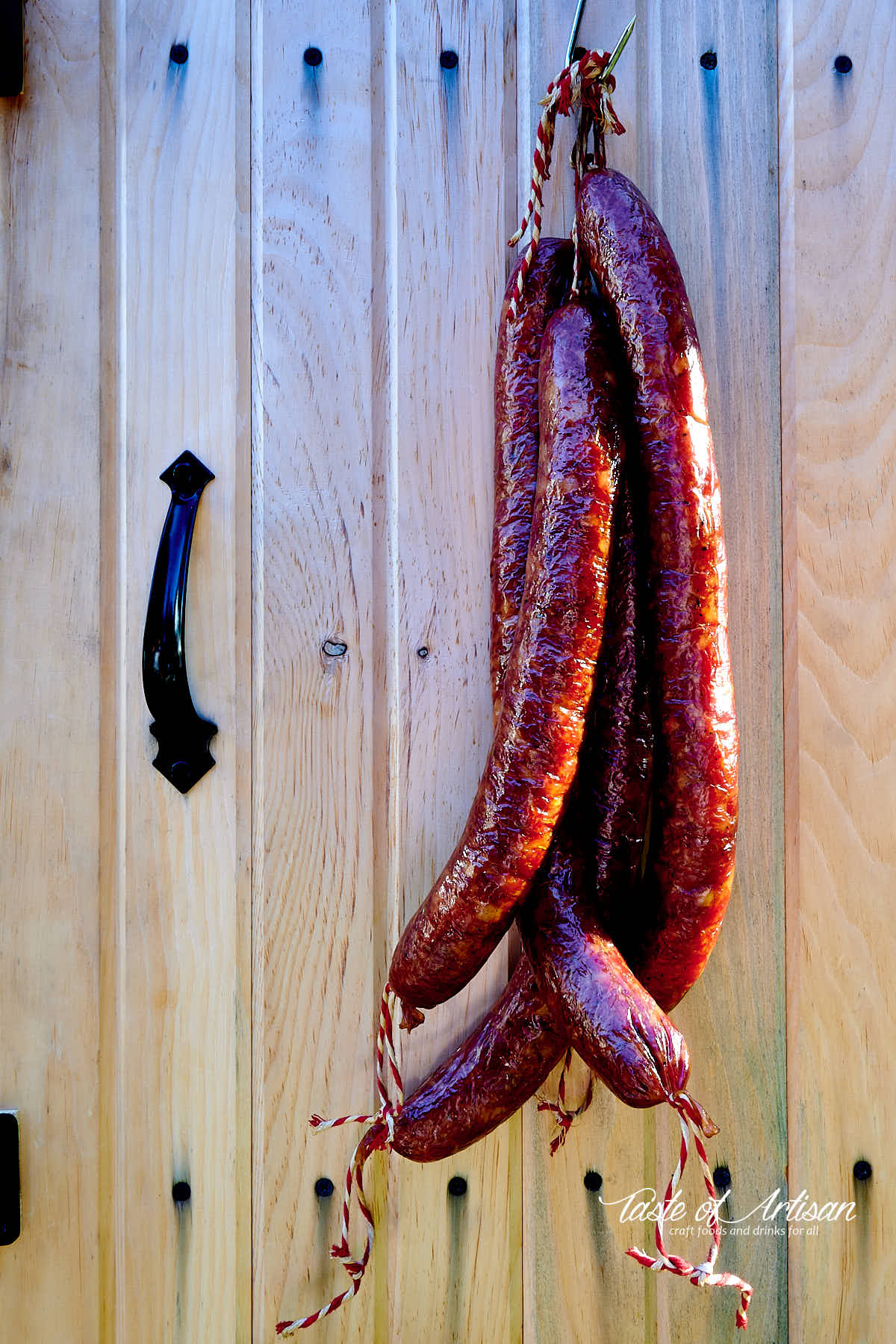
Andouille sausage is a classical Louisiana smoked sausage which is commonly used for seasoning gumbos, jambalayas, beans, and many other dishes. This sausage is a part of a family of original Cajun style meats and sausages: Andouille, Boudain, Chaurice (local version of Spanish chorizo) or Tasso (smoked pork butt).
Getting quality Andouille sausage outside of Louisiana has always been a challenge for me. After trying authentic Andouille you suddenly realize that none of the commercial mass-produced sausages come even close to the real deal. Mass-produced sausages are made quick and cheap, with flavor enhancers and preservatives, which negatively impact the taste. Some are spicy to the point of being barely edible. Some are just bland and tasteless.
The good news is that this sausage is quite easy to make at home. Just like good homemade kielbasa, all that homemade Andouille requires is fresh meat, basic seasonings and some patience as it needs many hours of smoking. It's the long smoke over pecan wood that defines Andouille flavor profile.
Andouille recipe
Sausage making guru Stanley Marianski in his Home Production of Quality Meats and Sausages book admits that it's not easy to come up with a universal Andouille sausage recipe. He points out that some recipes include dry red wine, while others introduce bay leaves, allspice, sage, paprika, crushed red peppers, sugar, onion powder, pequin pepper, mace, nutmeg, sage, ancho chili, filé powder, etc. The variations are endless, which makes it impossible to specify the 'real Andouille sausage'.
That said, according to Marianski, nearly all Andouille recipes he had examined agree on the following ingredients: pork butt, salt, cracked pepper, garlic, thyme, and cayenne pepper.
My favorite Andouille sausage that I had a chance to taste some time ago, Jacob's Andouille sausage, only includes salt, red pepper, black pepper and garlic, according to their website. These are the seasonings that I use in my recipe. My version is very close to their and sports chunky meat too.
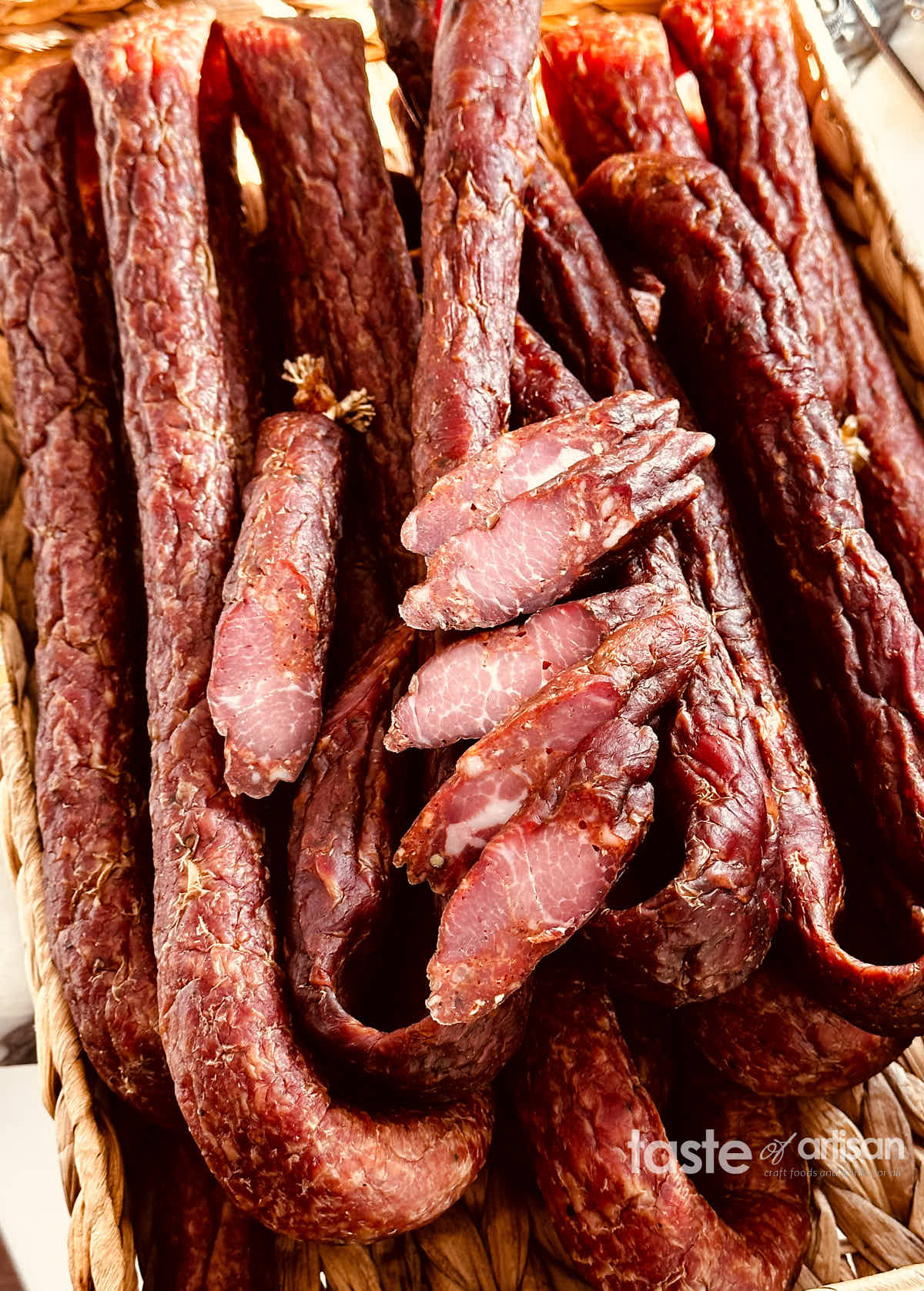
Making Andouille sausage
Preparing the meat
Traditionally, Andouille sausage is made of pork butt. The meat is trimmed of fat and then cubed or very coarsely ground. Jacob's makes Andouille from cubed, lean pork shoulder. Needless to say, this is a labor-intensive task. Stuffing cubed meat in smaller casings is also a challenge. The good news is that I found a great solution. I tenderize 1-2" pork cubes in a stand mixer fitted with a paddle attachment. This makes them easily go through the 3/4" and 1" stuffing tubes. I've tested that many times already.
If you don't have a stand mixer, use a meat grinder and a grinder stuffing plate. This will give pretty big chunks. If you have a 3/4" grinder plate, it's a good option too. At a minimum, use a 1/2" grinder plate. I grind fattier pieces through a 1/4" (4.5 mm-6 mm) plate.
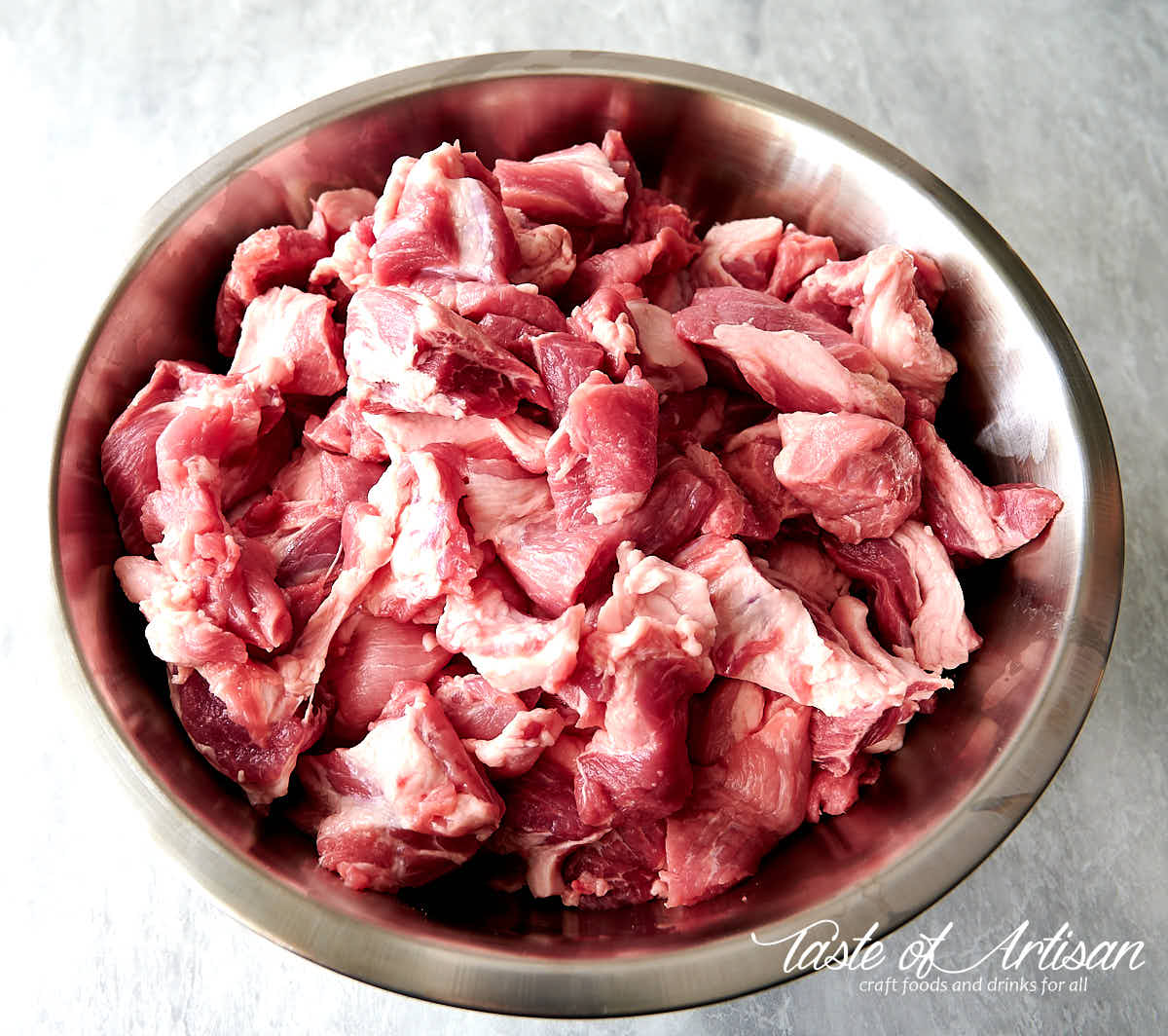
Stuffing and drying
Once the lean meat is cut into pieces and tenderized and the fattier meat is ground, I mix it with the rest of the ingredients, and stuff into beef rounds. Beef or hog casings of 38-40 mm are typically used.
I recently made an upgrade from my manual 5lb LEM sausage stuffer to their 20 lb motorized stuffer. What a difference! Loving the capacity increase and the ability to stuff even thin sausages quickly and without much effort. I used to always have my wife help me with stuffing sausages, now I can easily do it on my own. She appreciates it.
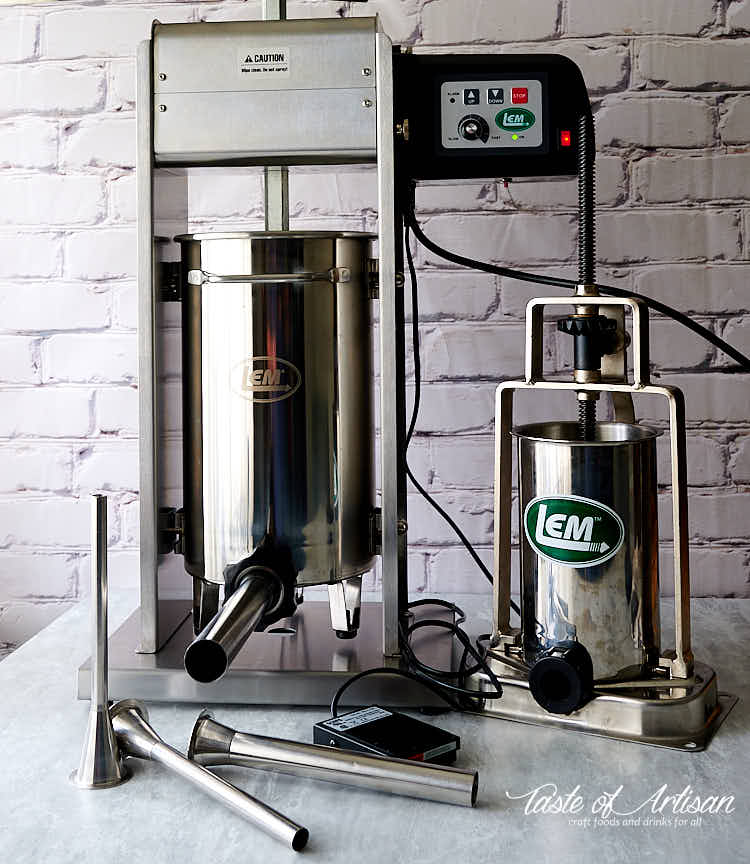
After stuffing, the sausages are cured for 12-24 hours in the fridge.
The next step is to dry the stuffed sausages. This can be accomplished by hanging them at room temperature for 2-4 hours, followed by drying them in a smoker for 30-60 minutes at 130F without smoke.
Smoking
Once the sausage casings are dry, raise the temperature to 140F and apply smoke. Andouille sausage is traditionally heavily smoked over pecan wood for a unique taste. Smoking takes anywhere from several hours to 10-12 hours, depending on the color and smokiness you want to achieve. The smokier it is, the better it will flavor the dishes to which it will be added. I smoked my Andouille for about 7 1/2 hours.
This is how my Andouille looked after about 2 hours of smoking in my new smokehouse. At this point, it definitely lacks color and robust smoky flavor.
This is after 7 1/2 hours of smoking.
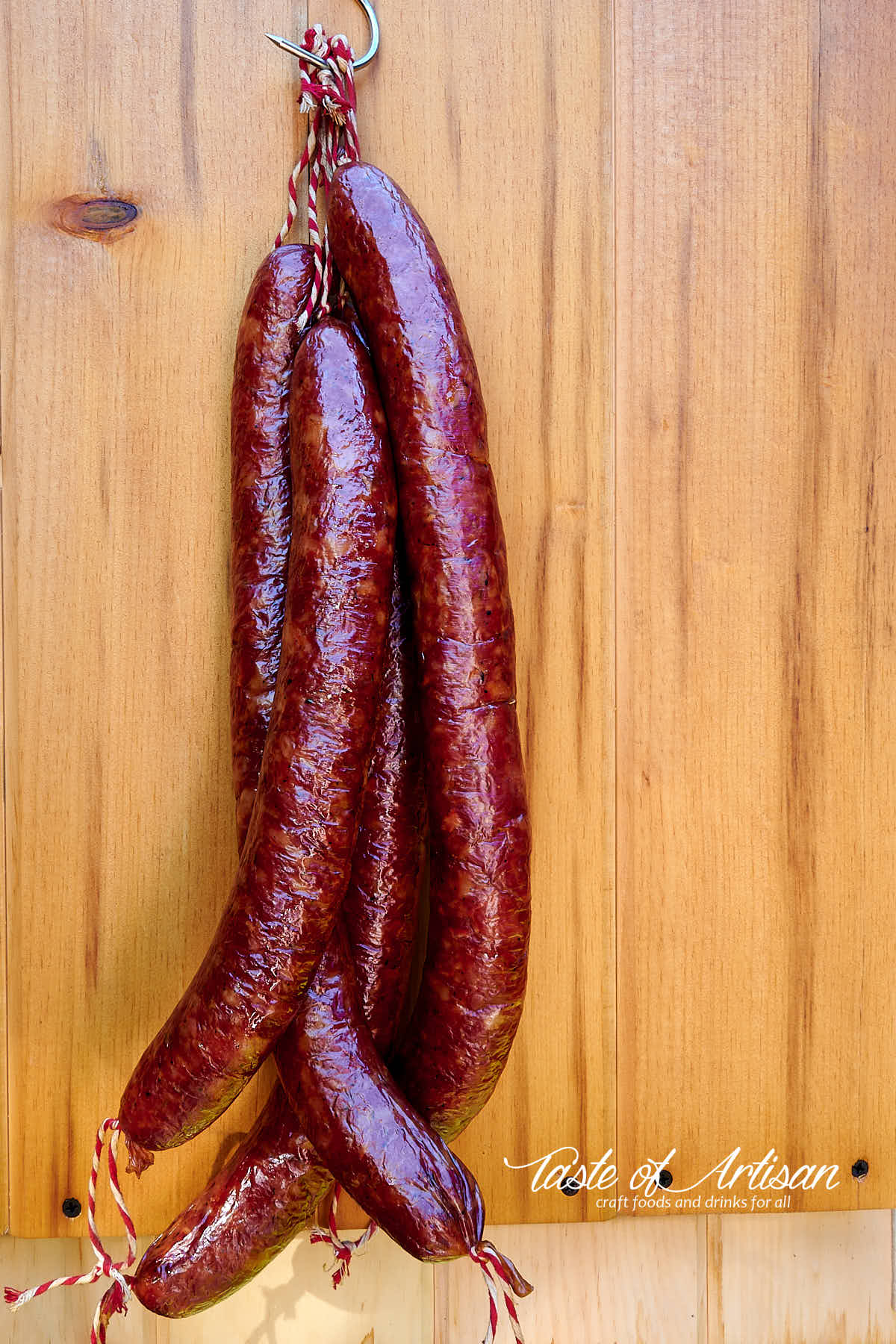
Finishing
Finally, once the desired rich color is achieved, Andouille is cooked at 170F - 195F until the internal temperature of 154F-158F is obtained. After smoking at around 140F- 142F for 7 1/2 hours, the internal temperature of the sausage reached 123F. I slowly ramped up the temperature in the smokehouse to around 185F before the internal temp reached 154F. This took about 40 minutes. Keep a bowl of hot water in the smoker. The more humidity you have in the smoker the faster this process will go.
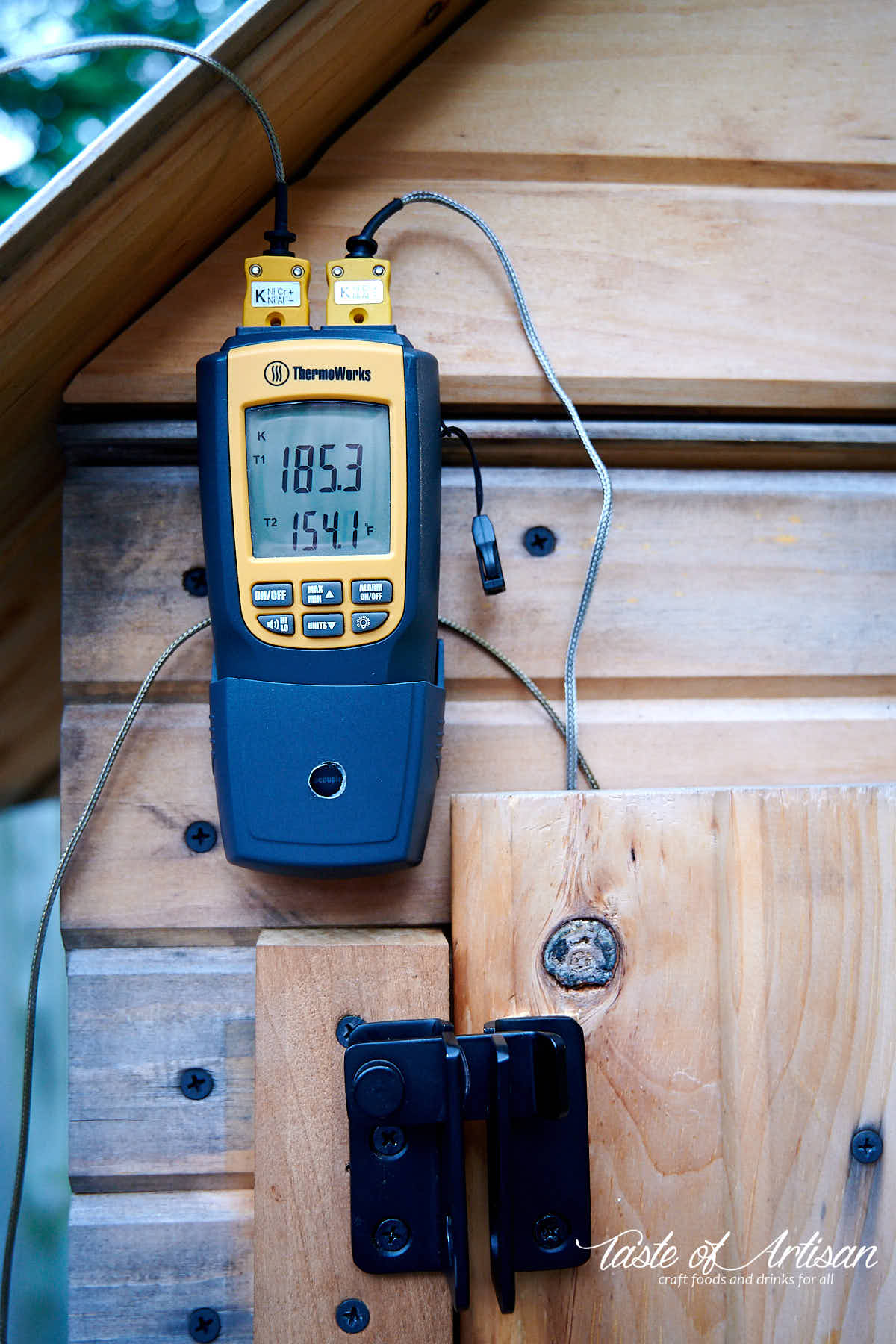
You can also finish cooking the sausages in the oven, but there is a chance of drying the sausage out. If you do, keep a pan with hot water in the oven to increase humidity. This will expedited the cooking process and prevent the skin from drying out.
Poaching the sausage in water at 170F - 175F for about 20 minutes or so is another good alternative, as well as steaming.
Alternatively, you may refrigerate the sausage right after smoking and cook later, for example, as part of your gumbo or jambalaya.
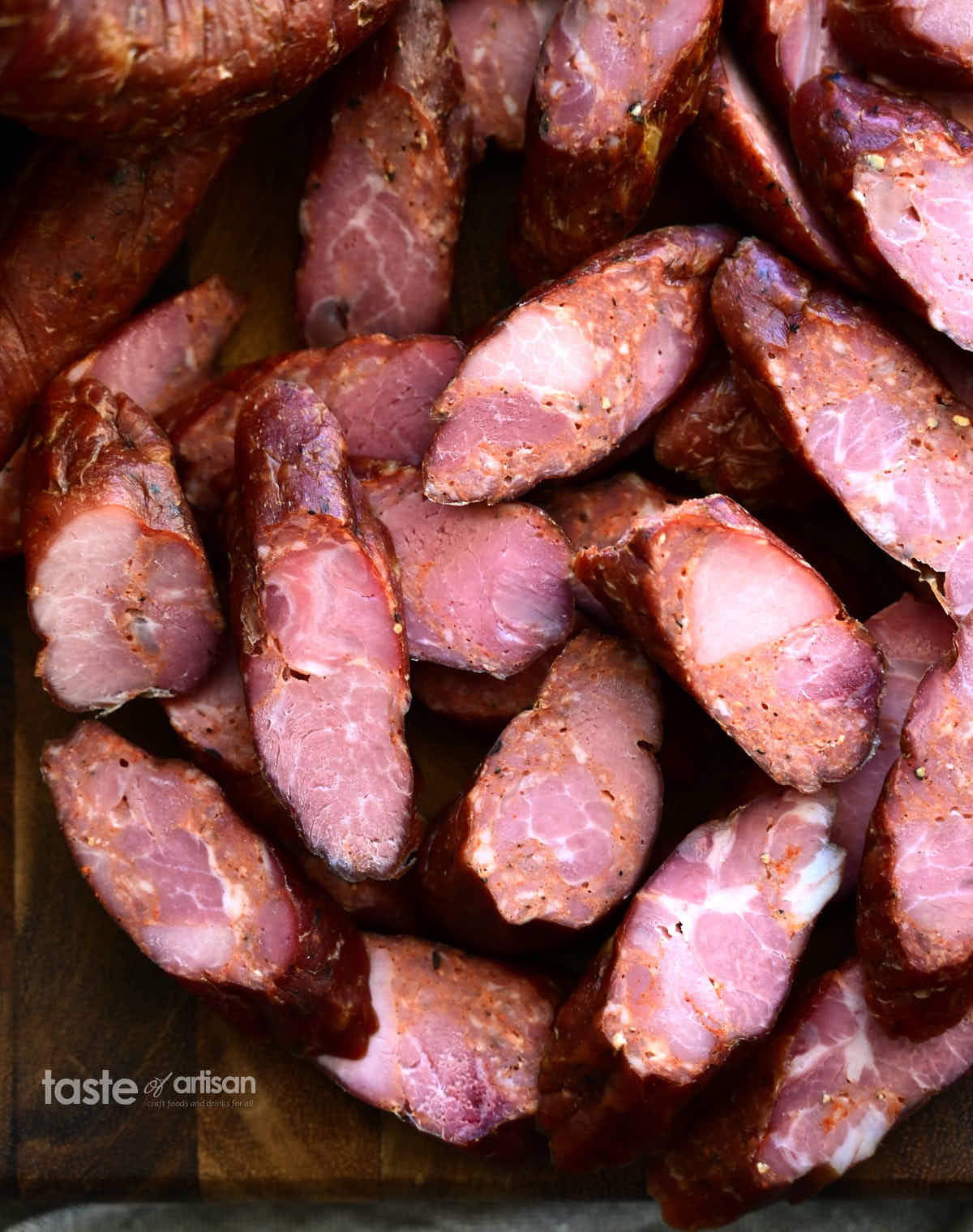
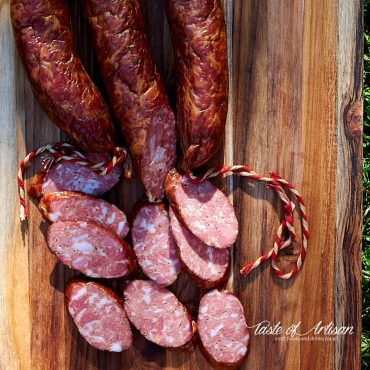
Andouille Sausage Recipe
Ingredients
- 1000 g pork butt (2.2 lbs)
- 13 g kosher salt (2 heaping tsp)
- 2 1/2 g Cure #1 (1/2 tsp, level)
- 10 g garlic (3 cloves, pressed)
- 5 g black pepper (2 1/2 tsp, cracked)
- 4 g cayenne pepper (2 tsp)
- 100 g cold water (1/4 cup)
Instructions
- Cut lean pieces of meat into 1" to 2" pieces and tenderize them in a stand mixer fitted with a paddle attachment for 3-4 minutes. If you don't have a stand mixer, grind them through a stuffing plate or 1/2" (12 mm) - 3/4" (18 mm) plate.
- Grind the fattier pieces through a 1/4″ (6 mm) plate.
- In a large bowl, mix the meat with the rest of the ingredients, including the water.
- Stuff into 38 - 40 mm beef or hog casings. Tie to make 12” links.
- Cure in the fridge for 12 - 24 hours.
- Dry for 2-4 hours at room temperature then hold for 30-60 minutes in a pre-heated smoker at 130F without smoke.
- Smoke over pecan wood at around 140F for about 8 hours until you obtain a nice rich mahogany color.
- Cook Andouille in the smoker at 170F - 195F until the internal temperature reaches 154F-158F. This should take about 30-40 minutes. Add a pan with boiling hot water to expedite the process.
- Chill quickly by placing on a cold marble slab or a similar cold surface.
- Refrigerate after cooling down. Keep wrapped in butcher's paper for best results.
Notes
Nutrition
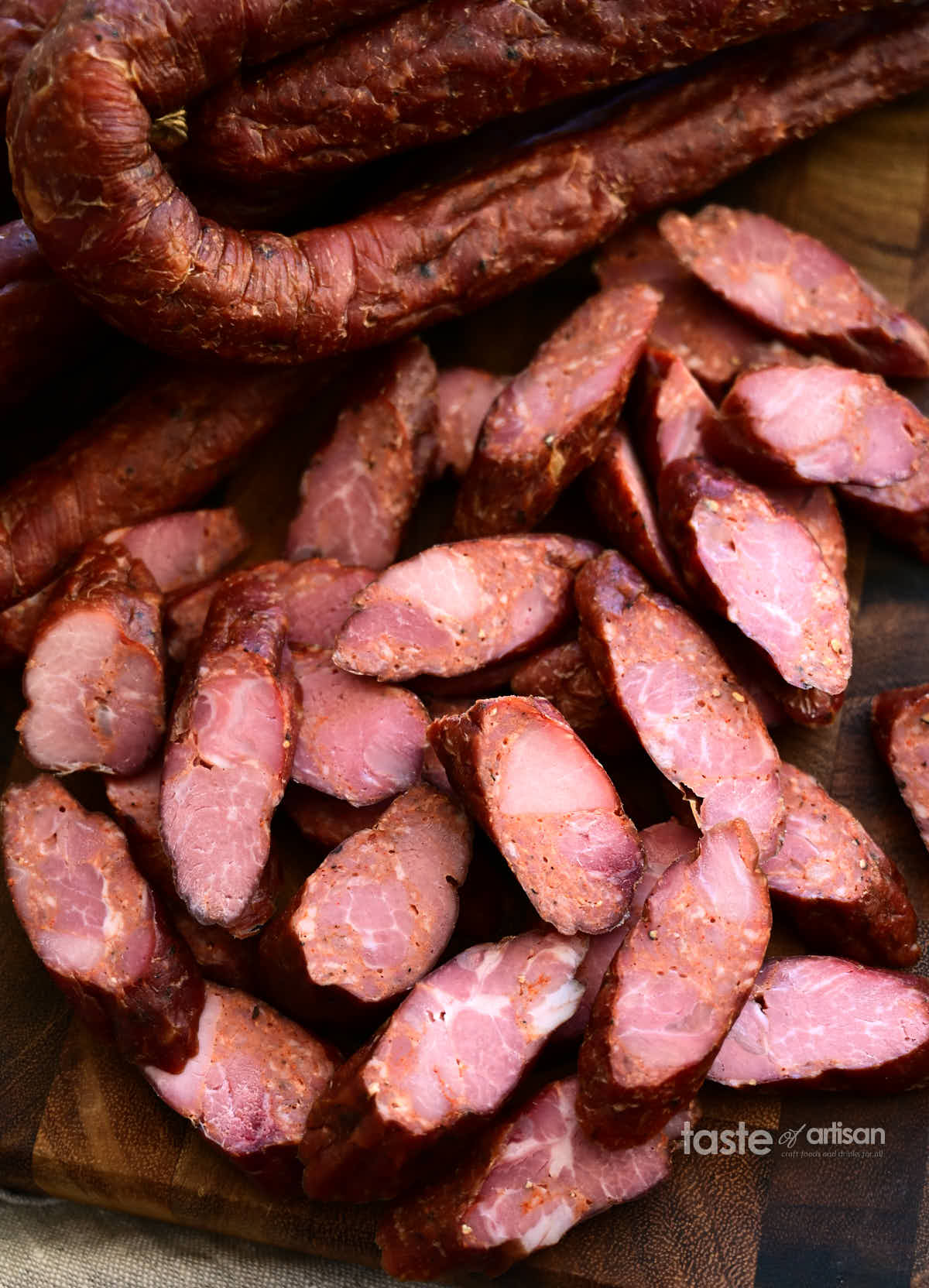


John Gary says
I don't have a stand mixer but do have a meat mallet for tenderizing needs. We also have a hand cranked grinder and stuffing tubes. I have made sausage with it before with success. Any suggestions for my using this? It is a metal mallet, one with coarse and smooth flat surfaces.
My son and I are interested in trying to make this recipe.
Victor @ Taste of Artisan says
john, a mallet will do just fine. You want to tenderize the meat enough so that larger chunks will pass through the stuffing tube easily, that's the idea. Good luck. This is a fantastic sausage.
Adam says
Hi there. Thank you for the valuable recipe. I’ve made Andouille a few times based off your recipe and been making tweaks here and there. All batches have turned out pretty well so far. I’m using an electric smoker with pecan wood chips. The smoker has a water bowl. Do you recommend using water in the smoker throughout the long smoking process at 140 F, or just when you crank up the temperature for the last 45 minutes or so?
I’ve used water throughout but wondering if I need it or not.
Thanks again. You’ve certainly improved my smoking ability.
Victor @ Taste of Artisan says
Hi Adam, glad to hear it. You are very welcome. About the water pan, it depends. Do you like your sausage moister or drier? If you want it moister, definitely keep the water pan all the way through. I noticed that the final stage where you raise the internal temperature of the sausage is alway challenging. Adding humidity helps getting there faster. Lately, most sausages that I make that are thicker than 21-23mm get poached. It's a lot faster and more predictable. I wrote about it in my Swojska Kielbasa recipe and some others. If you want to preserve the color and the smokiness, vac seal then poach. Good luck!
Larry Kelly says
Victor, I see you use beef rounds. Reading their description on Amazon it reads "not edible". Do you remove your andouille after cooling it off? Thanks, I have made.many of your sausages. Your drying process works perfect.
Victor @ Taste of Artisan says
Hi Larry, great to hear it. Yeah, those that aren't edible, you want to remove. But I've also been using hog casings that are larger diameter; those are edible. If you don't mind thinner Andouille, use regular 28-32mm hog casings. Good luck!
Wayne Tomaszewski says
Hope you don't mind, but I'd like to pick your brain here. I'm really enjoying the chunkier style of sausage you've made here, plus even thinking of trying the hot links that way, but in a bigger and longer casing. I like having a few different types of sausage open at a time, to have in the evening, or throughout the day with some crackers and different cheeses. Different sausages, different cheeses, different crackers, the possibilities are endless. YUMMMMM. Okay, my question is when I'm curing the meat separately with the salts, you have the Lisiecka curing for 48 hours, the Chorizo is cured 24-48 hours, but then your chunky Andouille,, you cut up the pork chunky, and make it right then. I'm guessing it wouldn't hurt to let the chunks cure for the Andouille like the Chorizo, and the ham needing more time since it's a denser meat, but is there a rule of thumb for how long to let the chunks cure before using? Like I said, I enjoy that texture of the chunks, and would like to use that in some of your other recipes here. Like the Hot Links, Hungarian, and maybe get brave and try it on a couple sticks of the summer sausage with chunks. Thanks for any feedback once again.
Victor @ Taste of Artisan says
Hi Wayne, you make me so hungry with yoour descriptions of different sausages, different cheeses, and different crackers 🙂 I want that!
Curing can be from just a few hours to 48 hours. I've seen many recipes that go from no curing, where the meat is ground, stuffed and smoked right away to a couple of days of curing. I don't think one is necessarily way better than the other and that there is a huge difference in the end products. But I do think now that a 24-48 hour curing allows for a better salt penetration and hence better flavoring, and, perhaps, better shelf life, but I have not tested that scientifically. I used to not cure at all to now curing at least a day and sometimes two days. It often depends on my schedule. If that's what you worry about, put them all on the same schedule, no need to have one 24 hours and another 48 hours, and yet another zero hours. Good luck!
wayne tomaszewski says
Thanks for the feedback. I didn't think it'd hurt anything. Like I said before, I've been making sausage for a quite a few years now, but, and a very sad but, it was all basically the bag season mixes. Want to try a different sausage, by a bag of seasoning. Get a bag of seasoning, grind and mix the meat, stuff it, let it sit overnight, and smoke it the next day. It was that way for years. Then I stumbled on your web site here, and this is an altogether different caliber of sausage I'm making now. I figured with the ham in the Polish, curing for a few days would help with the color of the meat, giving the Lisiecka that cooked ham look. Which it did. Like you said before, experiment. So I'm thinking of making a few different sausages here, and add the cure for the flavor, but make some 6 inch links, some bigger casing 18 inch tied links, and maybe even a few sticks of fibrous summer sausage size, just for different occasions. All with chunks, of course. Thanks again for all you do here for everyone.
Victor @ Taste of Artisan says
I guess I was talking about regular grind sausages in general in the previous post. If you don't pre-cure the meat and just grind and add the curing salt after gridnging, you will still get the benefit of the improved color and flavor. For chunky sausage, yes, you definitely want to cure the meat for a day or two. Two days would be better for larger chunks. Good luck!
Wayne T says
Hi, getting ready to make a batch of this Andouille, chunk style, and was wondering if you have a recipe hidden somewhere for the Chaurice or Spanish Chorizo you mentioned above? Hoping to be able to go the same way with them as the Andouille, making both fresh and/or heat smoked at the same time.
So many sausages, and so little time. LOL
Thanks
Victor @ Taste of Artisan says
Hi Wayne, I don't have it posted but I will. Good luck with the Andouille. I love this sausage.
Ken says
For this recipe, you say to tenderize the meat using a paddle attachment on the mixer. Does tenderize mean to just turn the mixer on low and let it go for a time?
Victor @ Taste of Artisan says
Yes. That's all there is to it. It works very well for me. Good luck!
Kevin says
Thanks for the recipe! Just to be clear, when trimming the pork butts did you grind the fat cap as well or just the intramuscular fat?
Is there an advantage to using the beef rounds vs hog casings?
Can’t wait to try this out!
Victor @ Taste of Artisan says
You are welcome, Kevin, glad you like it.
It depends. If there is too much fat, or the fat cap is too oxidized and doesn't look good, I will trim some off. The rest will be combined with the fatty trimmings and ground. In general, pork butts have a perfect ratio of fat to meat to make sausage so I don't remove much.
I don't think there is an advantage, both are good. I just go with what's readily available in the right size.
Let me know how it turns out and share some pictures. Good luck!
Victor @ Taste of Artisan says
Made another batch of this amazing sausage where I chopped the meat into 1-2" chunks and tenderized them in the stand mixer fitted with a paddle attachment. This method works very well every time, I was able to stuff the meat through a 3/4" tube as I used smaller cagins this time. Meat chunks make a huge difference to the texture of the sausage and stuffing them is a piece of cake now. See updated pics in the post above.
Dale Shihinski says
What ratio of chucks to ground pork would you guess Victor? 90/10% ground or so?
Victor @ Taste of Artisan says
Dale, I never bothered weighing them, but I'd say about 70-75% chunks and 25-30% ground, definitely not 90/10. Though it kind of looks like it.
Victor @ Taste of Artisan says
Just to clarify this more, I did not target any specific ratio. I just took a couple of pork butts, trimmed off large layers of fat and all the sinew, then cut out all the lean parts and cubed them. What was left was ground. I guess the ratio will depend on how patient you are doing all that trimming. If you just do quick and dirty you will probably end up with a 50/50 to 60/40 ratio.
wayne tomaszewski says
That really looks amazing. You can really tell the difference between having chunks of meat to all ground. Any idea of the ratio of chunk to ground before stuffing?
Victor @ Taste of Artisan says
I would say the biggest difference is the texture. All ground feels soft and kinda mushy, where as this one feels firm, like ham, but with some of the softness from ground. I generally like this kind of texture a lot more. It has a nice chew to it. The ratio was about 70-75% chunks and 25-30% ground.
wayne tomaszewski says
Just found your site and love the different types of sausage you make and share. Have a question for you, you ever used Fibrous casings on this, say summer sausage size? Retired now, and want to try more cured and smoked sausages and have them to slice, along with making fresh for cajun dishes. Thanks
Victor @ Taste of Artisan says
Yes, I've used collagen and fibrous casings of smaller caliber as well as very large ones. I prefer natural casings but collagen and fibrous work too. They are easier to use too.
wayne tomaszewski says
Thank you. Just found your site, and I see a lot of recipes I’ll be making. Really nice site you have, informative, and recipes for every taste. Be making a lot of different 10lb batches, let the family try, and then kick up to 25 lb batches. Be sending you some pics shortly of the finished sausage.
Victor @ Taste of Artisan says
Thank you for the kind words, Wayne, happy to see you here. Looking forward to seeing your pictures, always enjoy seeing what my readers create. Happy smoking!
Ken Vicknair says
This recipe is spot on! I live in Tennessee now but my home for 53 years is 13-14 miles from Laplace and Jacob’s Andouille. I was tired of having andouille shipped to me so I decided to make my own. What a great discovery to find your site!! Made a 2.2 lb. test batch last weekend and it was fantastic! Tonight I seasoned my cabbage dish with it and the wife was ecstatic. A much larger batch is in the works. Thanks for the recipe. Spot on!
Victor @ Taste of Artisan says
You are welcome, Ken. Happy my post helped you. Homemade is almost always much better.
Chip Staley says
Interesting recipe. I usually make 15-20 lbs. at a time and have been trying to pin down the iconic andouille taste I remember from my childhood. I don't think I could make 2.2 lbs at a time. My grandparents and aunt lived in La Place, LA just about a mile from Jacob's on Airline Highway.
I went to Louisiana last year to visit my cousin in Thibodaux and purchased a stick of andouille from both Jacob's and Wayne Jacob's Smokehouse ( the two "original" makers) for comparison. I carefully tested and analyzed them both and while both of them are will absolutely knock your socks off, Wayne Jacob's Smokehouse was the iconic flavor I remember as a kid spending summers with aunt and grandparents.
The spices used from both of these places are virtually the same but surprisingly, the cut of pork used to make it is different as is the ratio of fat that each one leaves in the meat. This change alone makes a remarkable difference in the flavor of the sausage. The almost $5 lb. difference in price should give you an idea.
I now have a program that I use that has all the ingredients measured in grams so it wouldn't matter if I made 2 lbs or 200 lbs, it will always taste the same.
Victor @ Taste of Artisan says
Welcome to my blog, Chip. No, I don't make 2.2 lbs at a time, this is just for reference from where you scale it. Say, you have 30 lbs of meat, you divide 30 by 2.2 and get 13.6. Now multiply all of the rest of the ingredients by 13.6 and make your 30-lb batch. Different people make different batch sizes, no recipe fits everyone's needs.
For me personally it's easier to measure the meat in grams, divide by 1000 and then calculate the amount of individual seasonings. Takes only a couple of minutes to do that.
Totally agree with you that the cut/grind/fat ratio alone makes a big difference when it comes to the final taste. That's the art of sausage making.
nas says
Any concerns with an extended refrigerated cure time? 36 or 48 hours? Longer?
Victor @ Taste of Artisan says
24-48 hour curing is very typical in sausage making. You can get away with a shorter curing time, I haven't noticed a significant difference. Longer curing time is not a problem either. I've made a few batches after 3-4 days curing simply because I got busy with other things and all was good. Longer than that - I haven't tested that though I suspect that the meat may begin to spoil at some time as there isn't enough salt and there is some liquid.
Giles says
So thankful I found this site! I’ve tried the kielbasa, pepperoni, and now andouille recipes. I am a hunter so I use wild meat mixed with pork while following your spices and techniques.
I just made a sausage using your andouille recipe but substituted cayenne pepper for Hungarian paprika. Amazing. Keep the posts coming!
Victor @ Taste of Artisan says
Hi Giles, thank you for the kind words, happy that you've found my blog helpful. Will keep them coming.
Richard D Schinella says
Sorry to say ...but I think you make this wayyy too technical!!! Do you think the people in Louisiana in the old days had smokers with the temperature control you speak of, or the ability to change temperatures on the dime? Granted your approach is great for replication of your process, but probably not an absolute requirement.
Otherwise your recipe looks pretty good.
Victor @ Taste of Artisan says
Richard, but we are not in the old days... things change, we become better, more educated, better equipped. No reason not to use all that to make a better sausage. That said, there are many ways to make a good sausage, mine is just one of them.
jodi leblanc says
excellent instructions and taste
Victor @ Taste of Artisan says
Thanks, Jodi. I am about to post the recipe for my chicken Andouille sausage. Incredibly tasty. I ate a whole ring last night, couldn't stop. You should definitely try it too.
Stephen says
I’d be curious as to andouille made with beef of chicken as we no longer eat pork..
Victor @ Taste of Artisan says
Haven't tried making it with beef, though thanks for the great idea, but here is my favorite chicken andouille recipe.
Duke Pousson says
Being a transplant Cajun from southwest Louisiana to Nebraska. I've longed for easy, precise recipes of different foods but, especially sausage. I am looking forward to making my own to add to my other Cajun dishes. It will beat driving to Louisiana to get that great Cajun flavor.
Joseph Catoir says
I really enjoyed this recipe. It's not so hot that it's overbearing. I used pecan shells and aged pecan wood. The color was perfect. I grew up in Louisiana and my family only used Jacobs Andouille. They have tried this and enjoy it.
Victor @ Taste of Artisan says
Hi Joseph, that was one of my goals too, to make it just hot enough but not overbearing. Sometimes you get Andouille from a store and can barely eat a couple of slices... A few years back bought some for a crawfish boil and no one really could eat that sausage it was way too hot, even for me who thinks he loves hot food.
Joe Catoir says
This is the closest in my opinion to Jacobs andouille. My family is from Laplace and Jacobs Andouille is the only andouille they have ever used. I had a specialty meat market in Denham Springs La 12 years ago and made it just like this and everyone loved it. Me and some family are opening another specialty meat market in the Baton Rouge area in the next couple of months and will be making it the same way again. Our offer was just accepted Friday on two acres so we will be opening soon.
Victor @ Taste of Artisan says
Thanks for the kind words, Joe. What's name of the place? I'd love to stop by when I am in your neck of woods again.
Todd Greene says
Sir, I grew up in La Place, Louisiana, eating the ‘good stuff’. I now live near Houston, Texas, and I started making my own sausages earlier this year, primarily because I miss the ‘good stuff’ I grew up on: GOOD boudin and andouille. Let me tell you, you nailed it on the head with your recipe! I’m not one who blindly follows recipes or takes them for granted, being a gourmet cook who also does occasional side gigs as a private chef, and I knew your recipe was a winner before even trying it. I’ve. Ow made it a few times and with great results that take me right back to my youth in La Place! My jambalayas, gumbos and red beans all taste as they should now, without taking a long road trip. Thank you so much for publishing this.
Victor @ Taste of Artisan says
Todd, you are very welcome. I am glad that you liked my recipe and that you are enjoying your Andouille. Thank you for the kind words.
Hyacinth says
Hello: Can you explain why I need to cook the sausage after smoking to 154 degrees? Can it not be eaten after cooling it down or refrigeration? Perhaps it needs to be cooked higher internal temp that smoking may make too dry? Just need further information. Thanks you!
Victor @ Taste of Artisan says
Smoked to 154F, Andouille and other smoked sausages are safe to eat as is but you can also cook it further as part of other dishes e.g. jambalaya.
Ryan says
I have read the comments here and I will add my input on this subject. But first a little bit of personal info. I grew up and still live about 15 miles from Jacob's andouille in Laplace. I have eaten homemade andouille all my life and have made my own using my dad's recipe since he passed away 5 years ago. This recipe is the most authentic and true to form andouille recipe I have ever run across on the internet. My process and seasoning blend is a little bit different but not much different. Great job on creating a true Louisiana recipe and posting it online.
Victor @ Taste of Artisan says
Thank you for the input and for the kind words, Ryan. Glad you like my recipe. I have many other good sausage recipes and more are coming. Hope you try and enjoy them too.
Stephen says
Sounds as if you and I draw from the same inspiration!.... I would get by LaPlace on a regular basis so sourcing great andouille was never an issue for me.. now... I’m at a point that I would have to make a trip out there specific. The last link I had kept frozen and would use a super-fine grater to shave little bits into my pot of grits... that my friend is FLAVOR HEAVEN!... So.. I too am cobbling together a smokehouse and have a more capable stuffer enroute to my door .. and will be making a short trip to pick up a heavier grinder.. thank you for taking the time to put this post together and sharing your fotos and experience.. have you since toyed with any additives to the smoke such as sugar cane ect?... ok then... beautiful product you turned out there
Victor @ Taste of Artisan says
Hi Stephen, I inspired a few of my friends to make a smokehouse and they all love the results. I also smoke some of my salumi and bacon. Love that smoky flavor. Speaking about additives, yes, I added sugar following my fascination with the Kabanos sausage recipe and like the results a lot. It's not much sugar but the taste improved for sure. I could go a little higher with it I think. I may also add some nutmeg and caraway in my next batch as I like the flavor they add. Not very traditional but very good.
Cajun Dude says
I've been looking for a good Andouille recipe for quite some time and this one is definitely it. I followed your suggestion and used 1" chunks and added paprika. The texture was perfect and the seasonings were spot on. Going to make another batch next weekend.
Victor @ Taste of Artisan says
Happy to hear that. Happy smokin'!
Will - Ohio says
Hi Vic,
Here is the follow up post for making my first Andouille batch. I used your seasoning formula plus some paprika for color with 1 – 1.5” chunks of pork butt meat that were heavily trimmed of fat. I followed your recommendation of using the mixer & paddle to tenderize the meat. Using large chunks of meat instead of grinding, requires some tenderization so they can be stuffed into the beef middles without air pockets. For the next batch, I’ll pound the meat chunks with a tenderizer mallet for added “pursuation”.
As for the cook on a reverse flow offset smoker, I started with 1 hour drying time @ 130 deg F, followed by 10 hours smoke @ 140 deg F, using pecan wood. The sticks were then finished off @ 190 deg F for 2 hours to an internal 165 deg F temperature. The weather was challenging, being 45 – 38 deg F with rain/snow/sleet changing back and forth during the cook. The sticks started out at 1.5 lb, 13.5” x 2” and ended up .5 lb lighter in weight.
The Andouille came out great with the Jacob’s style reddish seasoning around the large chunks of meat. While the Andouille was smoking, I prepared the jambalaya for a Fat Tuesday office potluck. The dish’s seasoning from the sausage was successful with just enough background pepper spice; not so much from the red pepper but more from the black pepper (most likely due to fresh ground vs. cracked). There were no leftovers in the pot and people gave rave reviews about the Andouille.
Thank you for your guidance on making a Jacob’s style Andouille sausage. The LaPlace smokehouses can get “back ordered” during certain times of the year, making it impossible to get Andouille on short notice. So, its nice to be able to make your own Andouille for cooking dishes with a great Louisiana sausage. I look forward to trying some of your other charcuterie.
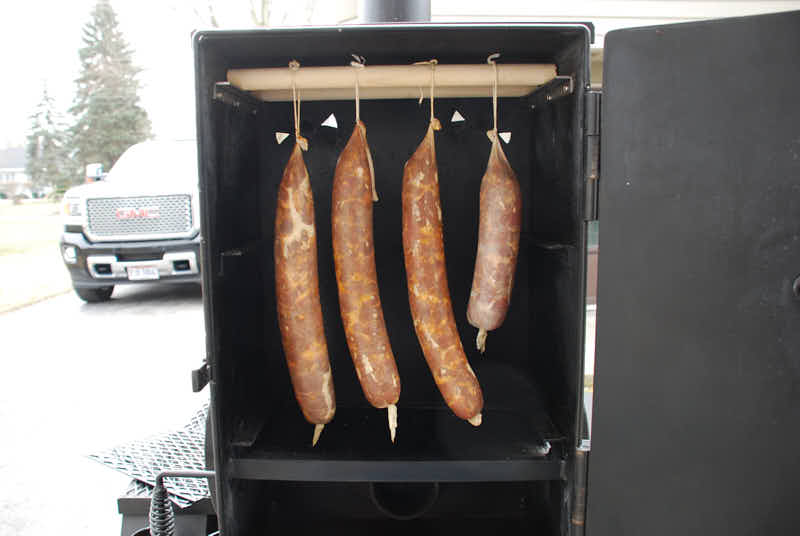
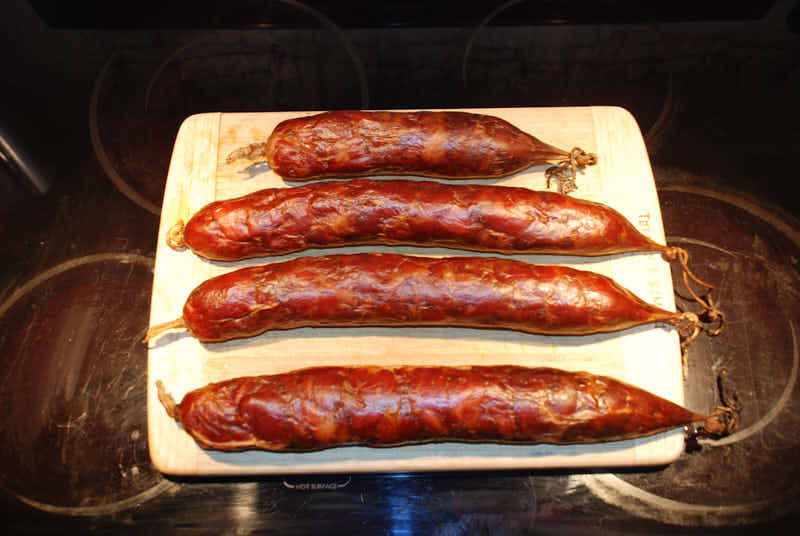
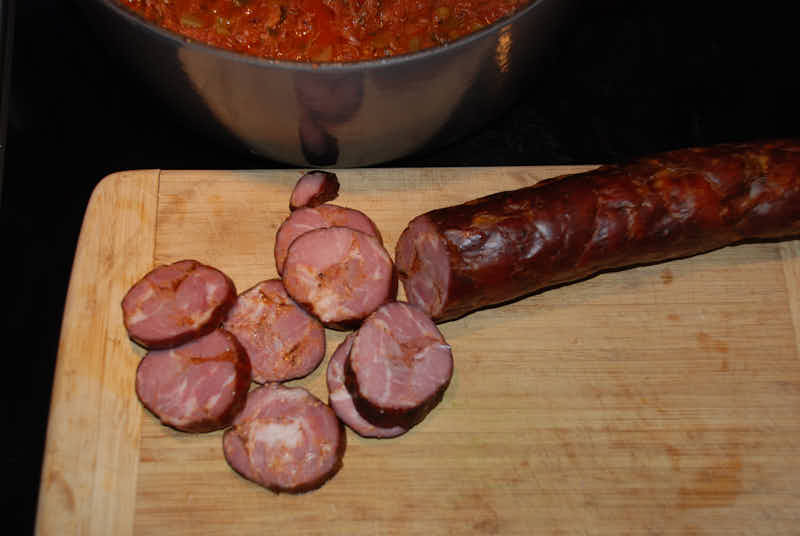
>
>
>
Victor @ Taste of Artisan says
Hi Will, thank you for the detailed feedback and helpful insights. Your sausages look fantastic, if I didn't know any better I'd say they came straight from Jacob's smokehouse. Seriously. Love the chunky texture, my next batch of Andouille will use 1" meat chunks, I now prefer that texture in many of my kielbasa recipes too. Lovely color. I will definitely add some paprika in the next batch. Anyway, thanks for your helpful tips. Looking forward to you trying my other recipes and providing your insightful feedback.
Will says
Hi Vic,
I have family that lives in LaPlace and I have been eating Jacob's Andouille for a long time now and it is our family's favorite. I always bring some sausage back to Ohio when I visit our family in southern Louisiana. Since my freezer is out of Jacob's Andouille and it's Mardi Gras time, I will make your sausage for my jambalaya to be served this Fat Tuesday. I'm using 5 lbs. trimmed pork butt chunks which is fattier than shoulder meat, so I will not add any fat to the mix. I will however, add paprika to the mix as the Jacob's Andouille always had a noticeable red seasoning ring around or in between the chunks of lean pork in the sausage. Since the red seasoning does not burn my tongue, I'm guessing it is some paprika (red pepper) in the mix. I'm not sure if I will pull the sausage at mid 150 deg F or finish it off at 165 deg F....the smoking process will determine the pull temp, as I'm having to modifying my smoker's warming box to hang the sausages. I will also use your recommendation of using a stand mixer & paddle to slightly "mangle" the chunks like a grinder with a very large 1" plate would. Nice job on your web site content and your smoke house. I will keep you posted on the Andouille results. Do you use the ceramic komodo cooker for the smoke house's heat/smoke source?
Victor @ Taste of Artisan says
Hi Will, thanks. So you think Jacob's adds paprika to their Andouille? It may very well be the case, even though they don't mention it on their website. I tried it such a long time ago that I can't recall well enough. Then again, recipes change.
>
Yes, I do use a BGE MiniMax for the firepit. I posted some details on my build on the Egghead Forum - https://eggheadforum.com/discussion/1221799/my-smokehouse-laid-a-green-egg.
>
Let me know how your sausage turns out, and take some pictures of the finished product. I'd love to see them.
John says
Hi Victor.
Great website. I just made Andouille for the first time using your recipe, and it exceeded my expectations. It is spicy, garlicky, and smoky, just how it's supposed to be. It's one of the best I've tried and I am quite picky when it comes to Creole staples. A+++!!!
Victor @ Taste of Artisan says
Thanks for the compliment, John. Make sure to try my other sausages, I posted quite a few really good recipes here.
Me says
That is no andouille sausage. It is just a basic garlic-pepper smoked sausage.
Victor @ Taste of Artisan says
I strongly disagree, but care to elaborate?
Jack Lithgoe says
There will always be the guy that knows it all. Just a troll. Ignore him. Andouille had its origins in France with strong German influence. Louisiana is where great andouille evolved, (LaPlace and Lake Charles) but recipes evolve over the decades, based on what meats, seasonings and even smoking woods, (even sugar cane and pecan shells) were available. All of these were locally grown and inexpensive. Changes were made based on how the locals responded to it.
What is important to remember is that Cajuns were resourceful but they didn't carry an andouille recipe as the Holy Grail to Louisiana. Most chefs, cooks and artisans agree that cooking is art and baking is science, hence making good andouille is art and allows for artistic license. However, ALL good andouille is made to season or marry the dish in which it is used, jambalaya, gumbo, red or white beans, greens, even just with good french bread, mustard and a beer.
But basically it is coarsely ground pork butt with about 25% pork fat, hot and spicy with black and cayenne pepper, salt, lots of fresh garlic and heavily smoked with pecan wood , white oak, pecan shells or sugar cane for 5-7 hours. Don't ever believe that there is only one way to make good andouille, or to skin a cat for that matter.
Victor @ Taste of Artisan says
Thank you Jack, that's an interesting piece of history and perspective on Andouille and sausage making in general.
Tim says
This is a legit recipe and with great detail. I live in La and this is done the right way. Thanks for the help, just made my first batch.
Victor @ Taste of Artisan says
Thanks. Tim. Glad I could help. I really wanted chunky meat but was afraid to use my stuffer to stuff meat chunks, so I ground the meat. Since then I've figured out a way to do that, I cut the meat into 1" pieces, tenderized in a stand mixer then stuffed using the largest tube I had, 1.25" in diameter. I worked great. I described the idea in my Smoked Lisiecka Kielbasa post. Next time I making andouille I will be doing that.